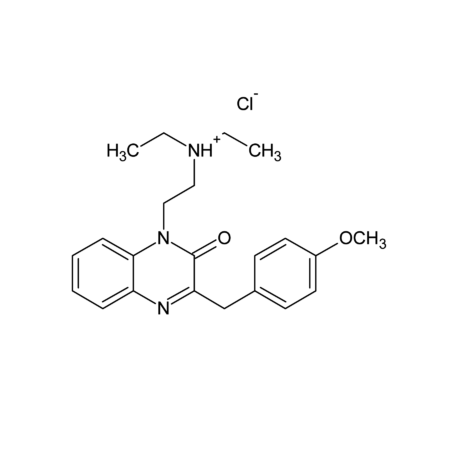| DC73624 |
FP802
|
FP802 is a novel small molecule with significant neuroprotective properties, specifically designed to target and disrupt the TwinF interface within the NMDAR/TRPM4 death signaling complex. This unique mechanism allows FP802 to selectively eliminate extrasynaptic NMDAR (eNMDAR)-mediated toxicity, which is implicated in various neurodegenerative diseases, while preserving the essential physiological functions of synaptic NMDARs. This selectivity makes FP802 a promising therapeutic candidate for conditions involving excitotoxicity and neuronal cell death. |
| DC71365 |
BZAD-01
|
BZAD-01 is a potent, selective and orally active inhibitor of NMDA NR2B subunit, with a Ki of 72 nM. BZAD-01 can improve postural asymmetry as well as Apomorphine-induced rotation. |
| DC44933 |
Caroverine hydrochloride
|
Caroverine hydrochloride is a potent, competitive and reversible antagonist of NMDA and AMPA glutamate receptor. Caroverine hydrochloride is also an antioxidant and calcium-blocking agent that exhibits vasorelaxant action. Caroverine hydrochloride can be used for the research of inner ear tinnitus. |
| DC28976 |
Dizocilpine free base
|
Dizocilpine, a potent anticonvulsant, is a selective and non-competitive NMDA receptor antagonist, with a Kd of 37.2 nM in rat brain membranes. Dizocilpine acts by binding to a site located within the NMDA associated ion channel and thus prevents Ca2+ flux. |
| DC28270 |
Topiramate D12
|
Topiramate D12 (McN 4853 D12) is a deuterium labeled Topiramate. Topiramate is a broad-spectrum antiepileptic agent. Topiramate is a GluR5 receptor antagonist. Topiramate produces its antiepileptic effects through enhancement of GABAergic activity, inhibition of kainate/AMPA receptors, inhibition of voltage-sensitive sodium and calcium channels, increases in potassium conductance, and inhibition of carbonic anhydrase. |
| DC11197 |
UoS12258
|
UoS12258 (UoS-12258) is a selective, positive allosteric modulator of the AMPA receptor with pEC50 of 5.6. |
| DC9852 |
Ro 25-6981 maleate
|
Ro 25-6981 is a potent and selective activity-dependent blocker of NMDA receptors containing the NR2B subunit. |
| DC10763 |
Philanthotoxin 74 (hydrochloride)
|
Philanthotoxin 74 dihydrochloride (PhTx 74) is an AMPAR antagonist; inhibits GluR3 and GluR1 with IC50s of 263 and 296 nM, respectively. |
| DC9341 |
Naspm
|
Naspm(1-Naphthylacetyl spermine) is a potent and selective Ca2+ permeable AMPA receptor(Ca-perm AMPAR) blocker.
IC50 value:
Target: CP-AMPAR blocker
Naspm is a selective blocker of Ca(2+)-permeable GluA2-lacking AMPA receptors, reduced MNNG-induced CA1 |
| DC10382 |
Farampator
|
Farampator (CX-691;Org24448) is an AMPA receptor positive modulator. |






















